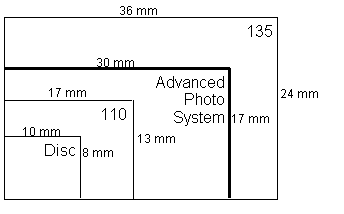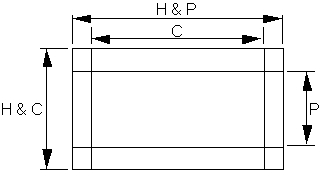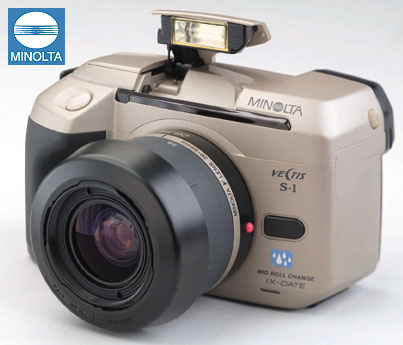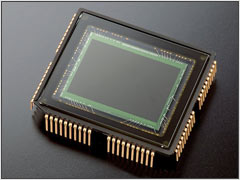Digital Photography from 20,000 Feet
by Wesley Fink on September 25, 2006 12:05 AM EST- Posted in
- Digital Camera
The Digital SLR
Several factors delayed the move to SLR technology for digital photography. First, the early sensors were much lower megapixel resolutions, far too low to begin to compete with film photography. Photo hobbyists saw few advantages to moving to a low resolution system since the reason they used an SLR was high image quality. It wasn't until resolutions reached the 2 to 4 megapixel range that there was any interest in a digital SLR.
Second, the early sensors were very small, developed primarily for video usage. Some tried to develop proprietary systems based on a smaller sensor size with more compact lenses, but nothing caught on in the industry. The cost of early sensors was also astronomical, making the early digital SLR cameras only useful for production, high volume photography where the cost could be justified.
Third, with sensor resolution and size in constant development it was much easier to design a point-and-shoot camera around each new sensor generation. Until sensor size stabilized, a digital SLR that used existing lens systems was not practical.
APS (Advanced Photo System)
35mm first appeared on the scene in the 1930s and the film format simply took 35mm motion picture film and spooled it into a light-tight canister. By the 1960s, with point-and-shoot and developments in SLR technology, 35mm had become king of the film formats. Even as film manufacturers tried to introduce other film formats, 35mm continued to grow and prosper. With the very early developments in digital photography, Kodak, Fuji and others saw the handwriting on the wall for film photography. One of the ongoing complaints about 35mm film, however, has been that the 2:3 image format required image loss in almost every standard print size. 8x10 and 5x7 are neither a 2:3 ratio and both required cropping of the 35mm negative.

In 1996 a new APS (Advanced Photo System) initiative by Kodak, Fujifilm, Minolta, Nikon, Canon and others was introduced to save film by standardizing on new ratios and adding new "computer-like" data storage capabilities in the taking and processing of images. APS included a new film size - 30.2mm x 16.7mm - that could be printed full-frame (H or HDTV format), or use standard crops of 25.1mm x 16.7mm (C or Classic 2:3 format) or 9.5mm x 30.2mm (P or Panorama). Actually, the image size that was always shot was the 30.2mm x 16.7mm, and the other sizes were just standard crops.

The industry was confident they could sell APS, which in the most common C view was only about 55% of the already small 35mm size. Some manufacturers like Minolta developed new APS lens lines with smaller cameras and lenses, and Canon and Nikon developed APS camera bodies that could mount their regular lenses - and a few custom APS lenses.

In the end, APS failed in the film market, but it is important in our discussion of Digital Photography because it was also a standard for digital development. At the time of the APS initiatives, it seemed reasonable to aim for development of digital sensors for that same APS format, so lenses for both systems were interchangeable. The industry aimed for the APS C size sensor, which would be about 16.7mm x 25.1mm the same ratio (2:3) as the classic 35mm format. This allowed existing 35mm lenses to be used, with a lens factor of 1.5 to 1.6, and the development of new lenses with a smaller image circle.
What do we mean by Lens Factor? Why does it matter?
The Lens Factor
APS really doesn't matter in the film market, except as a brief and intense flurry of activity that has produced a huge number of APS cameras in every imaginable format. Some of the high-end models are particularly interesting and will become collectibles. APS cameras like the tiny Minolta Vectis S-1 SLR system, the Canon IX, and Nikon Pronea are remarkably well-built and intelligent designs for the APS format.

The APS may be discontinued and dying in the film market, but it is alive and well in today's Digital SLR market. Today Sony, Nikon, Canon, Pentax, Minolta, Samsung and every other production SLR on the market (except Olympus) uses a sensor that is approximately APS C size. This matters because the lenses designed for 35mm SLR photography do not behave the same when used to capture images with the smaller APS sensor.
Several factors delayed the move to SLR technology for digital photography. First, the early sensors were much lower megapixel resolutions, far too low to begin to compete with film photography. Photo hobbyists saw few advantages to moving to a low resolution system since the reason they used an SLR was high image quality. It wasn't until resolutions reached the 2 to 4 megapixel range that there was any interest in a digital SLR.
Second, the early sensors were very small, developed primarily for video usage. Some tried to develop proprietary systems based on a smaller sensor size with more compact lenses, but nothing caught on in the industry. The cost of early sensors was also astronomical, making the early digital SLR cameras only useful for production, high volume photography where the cost could be justified.
Third, with sensor resolution and size in constant development it was much easier to design a point-and-shoot camera around each new sensor generation. Until sensor size stabilized, a digital SLR that used existing lens systems was not practical.
APS (Advanced Photo System)
35mm first appeared on the scene in the 1930s and the film format simply took 35mm motion picture film and spooled it into a light-tight canister. By the 1960s, with point-and-shoot and developments in SLR technology, 35mm had become king of the film formats. Even as film manufacturers tried to introduce other film formats, 35mm continued to grow and prosper. With the very early developments in digital photography, Kodak, Fuji and others saw the handwriting on the wall for film photography. One of the ongoing complaints about 35mm film, however, has been that the 2:3 image format required image loss in almost every standard print size. 8x10 and 5x7 are neither a 2:3 ratio and both required cropping of the 35mm negative.

In 1996 a new APS (Advanced Photo System) initiative by Kodak, Fujifilm, Minolta, Nikon, Canon and others was introduced to save film by standardizing on new ratios and adding new "computer-like" data storage capabilities in the taking and processing of images. APS included a new film size - 30.2mm x 16.7mm - that could be printed full-frame (H or HDTV format), or use standard crops of 25.1mm x 16.7mm (C or Classic 2:3 format) or 9.5mm x 30.2mm (P or Panorama). Actually, the image size that was always shot was the 30.2mm x 16.7mm, and the other sizes were just standard crops.

The industry was confident they could sell APS, which in the most common C view was only about 55% of the already small 35mm size. Some manufacturers like Minolta developed new APS lens lines with smaller cameras and lenses, and Canon and Nikon developed APS camera bodies that could mount their regular lenses - and a few custom APS lenses.

In the end, APS failed in the film market, but it is important in our discussion of Digital Photography because it was also a standard for digital development. At the time of the APS initiatives, it seemed reasonable to aim for development of digital sensors for that same APS format, so lenses for both systems were interchangeable. The industry aimed for the APS C size sensor, which would be about 16.7mm x 25.1mm the same ratio (2:3) as the classic 35mm format. This allowed existing 35mm lenses to be used, with a lens factor of 1.5 to 1.6, and the development of new lenses with a smaller image circle.
What do we mean by Lens Factor? Why does it matter?
The Lens Factor
APS really doesn't matter in the film market, except as a brief and intense flurry of activity that has produced a huge number of APS cameras in every imaginable format. Some of the high-end models are particularly interesting and will become collectibles. APS cameras like the tiny Minolta Vectis S-1 SLR system, the Canon IX, and Nikon Pronea are remarkably well-built and intelligent designs for the APS format.

The APS may be discontinued and dying in the film market, but it is alive and well in today's Digital SLR market. Today Sony, Nikon, Canon, Pentax, Minolta, Samsung and every other production SLR on the market (except Olympus) uses a sensor that is approximately APS C size. This matters because the lenses designed for 35mm SLR photography do not behave the same when used to capture images with the smaller APS sensor.










81 Comments
View All Comments
squiddy - Thursday, February 15, 2007 - link
I'm fairly versed in film and digital SLRs and have been shooting since the mid-80s. Nikon afficionado here but I did have a few Canon EOS film bodies back in the day. Currently use a D70s and soon hopefully a D200 in my bag.Anyway, as to sugestions for future reviews, the technical aspect tests are all well and good since numbers are always easy to quantify. The MP count, max resolution, test charts and etc do help people choose cameras after all. What I'd like to see more of are subjective reviews. How user-friendly is the camera? Are the menu's easy to navigate and the features easy to get to? How are the ergonomics and will my hand require a chiropractor after a long day of shooting? Is the camera balanced even when using a medium telephoto lens? How about accessories (flash kits, filters, battery grips, flash brackets, etc), are they useful for this camera or just gravy?
What made me write these additional questions is that I experienced it when I borrowed a Canon 350d for a friend's wedding. This was before my Nikon D70s and I absolutely loved/hated it. The pictures were great but required heavy menu navigation for white balance and iso settings. The camera was lighter than my old film Nikon so it wasn't tiring to carry all the time but the grip was awful. My pinky was sticking out under the body and a;; the weight was focused on the upper/rear quarter of my right palm. I'll tell you now, it hurts to use it for a long time. Especially with a 430ex flash. I then tried a friend's D50 and a D70 after that and it solidified my Nikon preference. Great ergonomics and the two dials give you much greater flexibility on the fly.
These reviews are probably aspects that the average consumer won't consider before purchasing and just focus on numbers but it greatly affects the usability of the camera in the long run.
Thanks guys and keep up the great work!
appu - Sunday, October 8, 2006 - link
I don't know if these have already been covered in the comments earlier. There are quite a few and I didn't read them all.1.) When talking about vibration reduction, you need to make sure you tell your readers that VR/IS *cannot* eliminate subject motion blur. It can only eliminate (to a degree) blur caused by handshake. I'm surprised you missed such an important point considering that you felt most AT readers are newbies at photography. It's all dandy to believe that VR gets you sharp images all the time. No, it doesn't. There are caveats and you might have mentioned them.
2.) The real benefit of SLR cameras is - more than anything else - the fact that the photographer sees what the lens sees. That's a major, major advantage of a SLR over point-and-shoots and rangefinders which exhibit parallax error by the nature of their design, especially if the subject is close to the lens/camera. Given this, you might have also mentioned that sensor-based stabilization techniques are a bit of a misfit (atleast that's what I tend to think) because having a stabilized sensor still *will not* give you a stabilized image in the viewfinder. However, lenses which have VR in-built *will* give you a stabilized image in your viewfinder - again going back to the "what you see is what you get" thing. Having stabilized sensors is good for the customers as they don't pay VR royalty on every lens they buy, but I don't see the point in seeing a shaky image in the viewfinder and somehow expecting something sharp (to what degree I may not know) in the final image. Maybe 99.9999% here (or anywhere) wouldn't agree with me on this point but I think it's worth a note.
3.) Not all kit lenses are dogs. The 18-70 DX I have for my Nikon D70 is a wonderfully sharp, contrasty lens (of course in available light situations) and after almost 2 years of shooting DSLRs I can safely admit that I've not "outgrown" this lens. It still manages to surprise me every once in a while and I don't see the need for an exotic f/2.8 zoom in this range as yet. Point I'm trying to make is - don't berate kit lenses. They are there for a reason, and as with any lens, there are certain advantages and certain disadvantages. As a photographer, it's important to understand what every bit of your equipment is good at and then maximize the technical potential of your images because of this understanding. Infact, building up on this point...
4.) I'll go so far as to say that, even with fixed focal length (prime) lenses, the so-called "sweet spot" in terms of image sharpness and contrast is usually achieved when the lens is stopped down by 1.5 to 2 stops from its maximum aperture. If you are always going to think in terms of how zoom lenses are "bad quality" compared to primes, I'd encourage you to start shooting 2 stops down on your primes (and thus lose all the speed advantage these primes offer). I think you get what I'm trying to say. Let's not get too hung up on trivialities like this because, and I repeat because, modern zooms, even the consumer zooms produce wonderful images in the hands of capable photographers. And then you have pro-grade zooms like the 70-200 f/2.8 VR from Nikon and Canon's 17-40 f/4L etc. Yes, they are costly, but so is a 300 f/2.8 VR Nikkor or a pro-grade ~100mm macro. The price differential is evident only when you start looking at wide-to-medium-tele or super-wide-to-normal fast zooms (28-70 f/2.8, 17-55 f/2.8) and even then the output from these lenses is well worth their cost and the walk-around convenience they present to photographers who prefer this range of focal lengths. So, not all zooms are "bad". Things have improved, just as they continuously do in the computer hardware business. Let's not get stuck in old notions based on old equipment manufactured using old processes.
Keep up the nice work!
appu - Sunday, October 8, 2006 - link
Ok, one last point -5.) In your second last page, you talk about "lens confusion" and how you'd like the industry to move to a standard naming of lenses. I don't understand what can be more standard than the focal length itself - a very physical property of a lens. A 35mm lens has a focal length of 35mm. Period. It doesn't depend on what format camera it's bolted on to. A 35mm lens is 35mm whether it's used on a 4x5 view camera or a 645 medium camera or a 35mm film camera or a digital equipped with an APS-C or.... you get the picture. In itself, the naming of the lens by its focal length (range, with zooms) is *not* confusing. What's confusing is what people make it out to be - quoting effective focal lengths for formats all and sundry, where as in reality, the measure everyone needs to be worried about is field-of-view. A 35mm lens will have different fields-of-view when used with different camera formats.
We don't need a standard for identifying lenses. We already have one - focal length (a physical property that doesn't change) and field-of-view (a very measurable metric). If anything, it's the "effective focal length" paradigm has to be done away with, IMHO.
appu - Sunday, October 8, 2006 - link
In the last line of the third from last paragraph - Nikon doesn't make a 11-18mm as far as I know. They do have a 12-24 f/4 DX and Sigma also has a 12-24 (I think a non-constant aperture) which can be used on full-frame cameras too, unlike the Nikon 12-24 DX. The 11-18mm is made by one (or both) of Tamron and Tokina I think.directed - Wednesday, September 27, 2006 - link
When reviewing DSLRs, I want to know how quickly they can autofocus in different lighting conditions. I want to know how good the autoexposure is in different situations. I want to know how the different flashes perform in different settings (not just the built in ones, but the ones you can buy for them). I want to know how accurate the color reproduction and contrast is. I want to know how good the jpg compression is (lets face it, few people will be using RAW). I want to know how long the batteries will last in different situations. I would also like there to be a comparison with other models in a similar price range as well as a comparison with the cheaper and more expensive models of the same manufacturer.Boy, looking at my post I sound demanding. LOL, I'm sure Anandtech is up to the challenge.
yyrkoon - Wednesday, November 1, 2006 - link
I dont know, I dont use AF for demanding lighting situations, I use the infinite Focus setting, and set the rest manually. That, and I think all 'prosumer' DSLRs have a fairly 'shitty' on cam flash, and alot of us would probably be more concerned with the hotshoe 'adapter'However, I will agree with battery life as an important factor, but to be honest I'm personally more concerned with how fast the camera is (FPS), and the media type used.
I see alot of stuff on dpreview.com like 'default <insert something relivent> setting is BAD' etc, but most of the these cameras can be manually adjusted away from default settings, so, IMHO, it's a moot point, and is pointless to really mention, learn how to use your camera ;)
You're not demanding, you just know what you want :)
yyrkoon - Wednesday, September 27, 2006 - link
Forget what all the nay sayers are saying guys, write you articles. I've been interrested in the Sony A100 for several months now, since the preview on dpreview.com. I also think you're right concerning the *mass* of information that dpreview gives off for thier camera reviews, most of it is un nessisary for all but the professionals, most of us just want to know things like, how many FPS does the camera achieve, how does it handle low light situations, how clean are the photos, etc.Carry on :)
silver - Wednesday, September 27, 2006 - link
Another good point. AT has always been about presenting good, practical information on the products that we use and in this context has always done a great job.The A100 certainly has my intrest as well but do note that most pro's do not need bells and whistles in their equipment. In fact most don't even want them available as it adds to both cost and complexity with almost no practical return in value.
Lord Midas - Wednesday, September 27, 2006 - link
Very good article Wesley. Thanks.Still a lot of this is still baffling at the moment but that should change when I get my Canon Rebel XTi 400D for Christmas.
What I would like to see in the reviews would also include the quality of the bundled lens (the Canon comes with the 18-55mm lens). As well as with a quality lens.
Will you also include reviews of lens:
For example you do the "Mid Range GPU Roundup - Summer 2006"
So you could do this with Normal, telephoto, etc lens.
So instead of reviewing one lens you can do a group test.
And I also think that a few standard photos for all the reviews would be good (indoor, outdoor, macro, etc) and a few random ones the the reviewer would think we would like.
Keep up the good work. Thanks.
mesonw - Tuesday, September 26, 2006 - link
Just wanted to add my 2p-worth. I feel I fit fairly well into the target audience you're aiming at. I'm very lacking when it comes to the technical details of cameras, digital or otherwise, yet I have a great desire to take good and interesting pictures.It's good for people to offer tips and ideas for your upcoming articles, but I don't see the point of the very knowledgeable and camera-savvy crowd out there making harsh criticisms simply because you're targetting people with less knowledge than them. Like they say, there are other sites to get in-depth information if they want it, so why berate AT for catering for others?
I for one look forward to your articles on the subject, because I know they will be well written, provide useful information and insights, and very likely make me a better amateur photographer.
Good work AT.